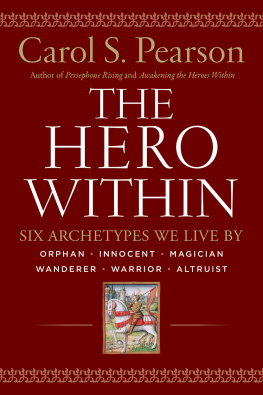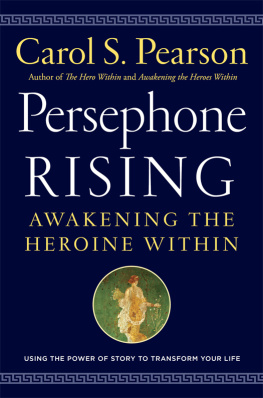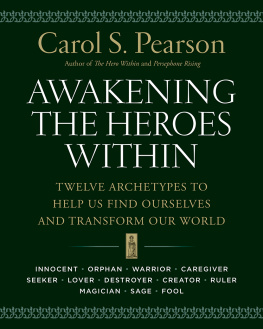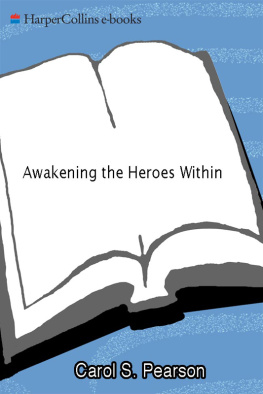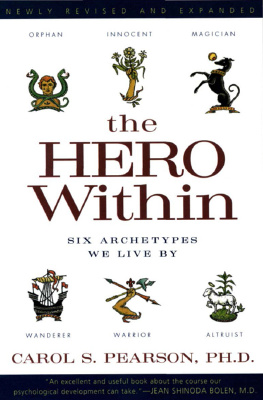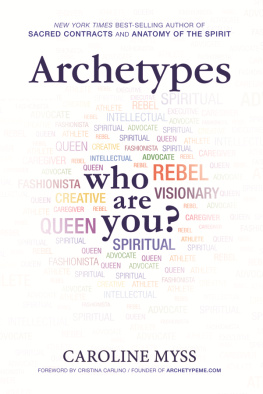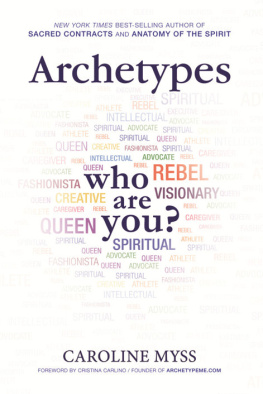I am inspired to revise and expand this work by the many readers who have shared with me the stories of their heroic journeys and anecdotes about ways The Hero Within touched their lives. I have been moved, encouraged, and occasionally challenged by the mail, phone calls, and e-mail I daily receive. I have learned not only from readers, but also professionals whom I have trained in the use of this model and other similar ones. It is fascinating to me that although I have been working with these materials for years, others using them always come up with some nuance or even breakthrough insight I have missed. I am particularly grateful for insights from what I call my training faculty dream team: Patricia Adson, whose book True North provides practical guidance for psychotherapists on the uses of these and other archetypes with their clients; Eileen and Patrick Howley, who apply these models to the training of educational leaders; Chris Saade, who integrates these ideas with existential philosophy/psychology and whose emphasis on the importance of existential choice strongly influenced this revision; and Suzanne Guy, who edits Heroes Ink , a newsletter to support people who are using the heros journey model in their lives and work.
A number of theories positively influenced the development of these models. The three major philosophical traditions this book integrates and develops are: Jungian psychology, scholarship on the heros journey, and new-thought spiritual principles. In the Jungian world, I wish to acknowledge particularly C. G. Jung, who provided the pioneering studies of archetypes, without which this book could not have been written; James Hillman, whose archetypal theories were essential to its development; and Frances Parks, whose skillful analytical training provided guidance in understanding my own inner archetypal life. For the heros journey material, of course, this book would not have been possible without the scholarly achievement of Joseph Campbell and the practical applications of these theories by David Oldfield, whose example was extremely helpful in developing the exercises herein. For insight into new thought spiritual traditions, I am particularly indebted to the work of Eric Butterworth.
Other theoretical perspectives that influenced my thinking include gestalt therapy, the fields of womens and ethnic studies, cognitive psychology, learning theory, family systems theory, and organizational development/systems theory.
I also am grateful to a series of editors who treated this book with professionalism and care: Pat Lassonde, who edited the first edition; Tom Grady, who edited the second edition and proposed this third edition; my agent, Angela Miller, who convinced me to take it on; Mark Chimsky, who edited this edition and provided invaluable guidance during the writing process; and Ann Moru for copyediting. I also thank Edith Lazenby for her work typing revisions for this book and my husband, David Merkowitz, for his substantial help in the writing/editing process and for his unfailing love and support.
The Heroic Myth Self-Test is designed to measure the archetypes present in both their positive and negative forms in your life. In responding to this questionnaire, you will be asked to reflect on your own archetypal qualitiesas you see yourself and as others see youand to identify the archetypes that affect you because they were active in your family of origin when you were a child or are active at present in your current family, school, and/or workplace.
Check all the words or phrases listed in both column A and column B that describe the way you see yourself.
Column A: | Column B: |
(I see myself as) | (I see myself as) |
|
_____resilient | _____suspicious |
_____a survivor | _____negative |
_____realistic | _____cynical |
_____empathic | _____a whiner |
|
_____individualistic | _____a loner |
_____a pioneer | _____a rebel |
_____autonomous | _____afraid of closeness |
_____a divergent thinker | _____having trouble fitting in |
|
_____assertive | _____ruthless |
_____a winner | _____overly competitive |
_____disciplined | _____stubborn |
_____tough-minded | _____inflexible |
|
_____caring | _____a martyr |
_____conscientious | _____intrusive |
_____willing to sacrifice | _____guilt-tripping others |
_____generous | _____controlling |
|
_____optimistic | _____seduced by easy answers |
_____trustworthy | _____gullible |
_____trusting | _____naive |
_____morally good | _____goody-goody |
|
_____visionary | _____too far out |
_____creative | _____weird |
_____powerful | _____manipulative |
_____a catalyst for change | _____too great a risk taker |
The numbers 1 through 6 correspond to the six archetypes in this book. Column A lists archetypal traits that generally are viewed positively. Column B lists archetypal traits that generally are viewed negatively. Count each check as one point and add up your subscores in each column as follows. Your scores will range from 0 to 4 on each scale.
Archetype | A. Positive Total (04) | B. Negative Total (04) |
1. Orphan | _____ | _____ |
2. Wanderer | _____ | _____ |
3. Warrior | _____ | _____ |
4. Altruist | _____ | _____ |
5. Innocent | _____ | _____ |
6. Magician | _____ | _____ |
You can create a bar graph of your subscores on the following chart. Fill in your A score going up and your B score going down for each archetype. Shade in the box of your positive score above the zero and the box of your negative score below the zero. Then connect the two by shading in the boxes in between.
The hard part of assessing ones own archetypes is that most of us do not see ourselves accurately. Some people emphasize their positive traits and minimize their faults. Others tend to stress their faults and miss their virtues. Almost all of us have a self-image that is somewhat out of date (that is, we see what we were, not what we are). Therefore, it is useful to take a look at how others see you. There are two ways to do this. The easiest way is to fill out this part yourself, focusing on what others tell you (or even complain to you) about yourself. If you do it this way, follow the instructions in Part I, only focus on how you are seen rather than how you see yourself. The more time-consuming but accurate way is to make copies of this part of the instrument (crossing out the second set of parentheses below the column titles) and give it to three other people (ideally, one relative, one friend, and one co-worker) who know you well and will be honest with you. Then compare your self-appraisal with the appraisals done by others.

